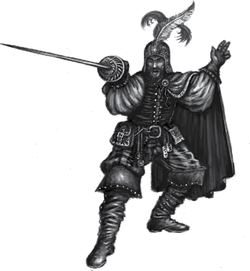"I will parry your prima attacks on my three-quarters radial, and take zeh high ground. With just a fifty-three inch reach, you can’t win this fight using a cutting blade. Not with such a poor stance, senor."
- —Anonymous Diestro.[2]

An Estalian Diestro.
Diestros are skilled swordsmen hailing from the southern realm of Estalia.
Overview[]
The Estalian Kingdoms are southwest of the Empire. There the threat of Chaos seems remote. The Chaos Wastes are quite distant from this sunny land, which has never witnessed the wrath of bloodthirsty hordes the way the Empire and Kislev have. Its people engage in other pursuits, from science and scholarship to crime and vendetta. One thing Estalians dearly love is swordplay. Its cities sport many fencing schools, each with its own style. Many of these styles are descended from the teachings of Master Figueroa, a legendary swordsman who applied the latest scientific theories to his swordplay with spectacular results. Followers of the Figueroa style, known as Diestro, fight and duel across Estalia. Some, bored with their homeland, seek excitement elsewhere, favouring Tilea and Bretonnia. The bravest travel northeast to the Empire to test their rapiers against worthy opponents, and to see a land in the front line of the struggle against Chaos.[1a]
The Knights of Bretonnia and Diestros of Estalia have been known to harbour rivalries. They have very little understanding of one another's fighting styles, and this incomprehension has been responsible for much of the existing tension between the realms.[3a]
Sparring Words[]
Estalians are known to be talkative and vivacious people, both in love and quarrel. Between Diestros, engaging in dialogue during combat is expected. Non-Diestros, although not expected to reciprocate, aren't spared the verbal assault that accompanies a Diestro's rapier.[2a]
- Introduccione: Diestros consider it poor form to cross swords without first introducing oneself. In a tournament, the fighter who draws steel before exchanging formalities is disqualified. This is an appropriate time to comment on reputations and parentage.[2a]
- Metodologia: Amid the opening thrusts and parries of combat, a Diestro explains how he will win, in technical or even mathematical terms. Tournament discourse follows a strict code, allowing either party to question the other's calculations. Street fights are somewhat less orderly, sounding more like jargon-shouting contests.
- Critica: After several blows have been traded, Diestros vocally analyse the other’s technique. Individual personalities set the tenor of this analysis, but usually the goal is to demoralise the enemy. In theory, tournaments enforce polite conduct, but in practice this only encourages veiled insults and false platitudes.[2a]
- Ultimos Floreo: The winner customarily salutes his fallen opponent with a dazzling flourish. If the opponent is still alive, a verbal summary of the fight may follow. Tournament fighters must yield the last word to the victor.[2a]
Famous Diestros[]
- Estevan and Casanova - Two of the greatest Estalian Swordsmen in recent memory.
